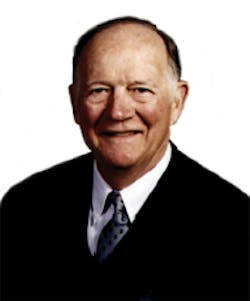H. James Henning, 1931-2009
Harold James Henning, a veteran researcher and consultant on forging technologies, and a longtime advocate for industrial and organizational training programs for forging operations, has died. Henning battled cancer for the past several months, and passed away at home on February 2. He was 77.
A native of Chicago, Jim Henning graduated from the Michigan College of Mining and Technology (now Michigan Technological University), Houghton, MI, in 1953, with degrees in metallurgical and mechanical engineering. His career included positions of responsibility in the metallurgical departments of Wyman-Gordon Co. and Ladish Co., where he was a leader of research programs into non-destructive testing techniques and ways to improve the metallurgical quality of nonferrous and ferrous forgings.
As director of engineering at Metal Forge in Columbus, OH, Jim was actively involved in the development of a new plant dedicated to efficient cold and warm forging of automotive suspension and steering components. This included efforts to improve employee training and education, in addition to facility design and tooling selection. Jim was instrumental in the forging industry’s adaptation of value-added production, in response to changing demands from automotive customers for highly engineered products that are “ready to install.”
As the Battelle Memorial Institute’s research leader in metalworking, Jim led many industrial and governmental research programs on warm forging, cold forging of steels and nonferrous alloys, and forging of cast and powdered metal preforms.
Titanium-alloy forging was a subject of particular strength for Jim, and many advances in that area can be credited to his technical research and reporting. He also contributed much to the research on forging of iron-based and nickel-based superalloys, PH stainless steels, and magnesium and aluminum alloys.
In all, Jim spent 44 years as a technician, engineer, and supervisor in the forging industry prior to his retirement, including nine years as technical director of the Forging Industry Assn.
Upon his retirement from FIA in 1996, Jim formed Henning Educational Services Inc. There, he filled a problem-solving role for forgers and other manufacturers seeking solutions to process and organizational issues. He shared his expertise on hot, cold, and warm forging, on tool design principles, process and equipment selection, and productivity and quality improvements.
FORGING readers will remember Jim’s regular column in our pages, which first appeared in 1997. In each issue, “Ask Jim” shed light on forgers’ problems, from material selection and process tactics, to thermal effects and failure analysis, and covering all manner of forging, press, and ring-rolling operations.
“Ask Jim” was a continuation of his work, but just as important it was an extension of the man. Fielding readers’ inquiries, Henning would spend days or weeks researching answers, working through the possible causes and identifying plausible solutions. Most important, Jim dispensed careful advice. Readers appreciated the thoroughness of his answers and, even more, the concern he showed to the details of their forging operations.
Henning’s columns consistently earned readers’ endorsement as the best elements of FORGING magazine. His loss is a personal one for us, and for all those in the forging industry who’s work and life were improved by the insights and contributions of Jim Henning.
